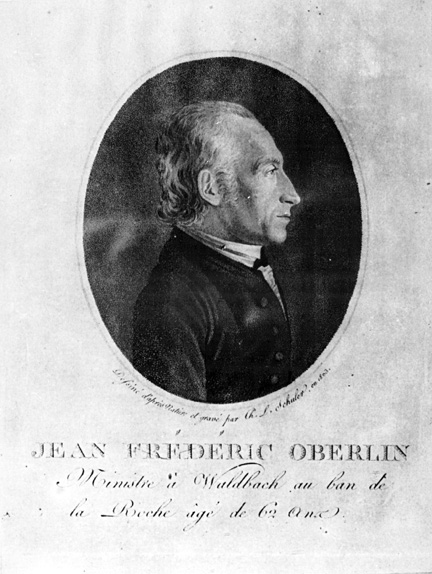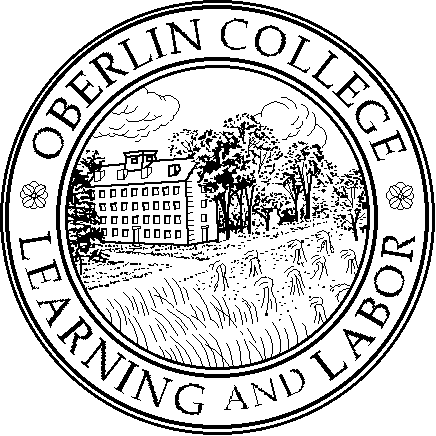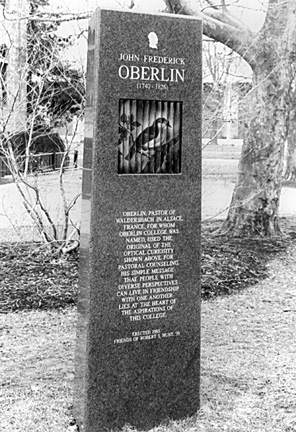Both the town and college of Oberlin began as ideas in the minds of two ministers. John Jay Shipherd, and his student, Philo P. Stewart, spent the summer of 1832 together in the village of Elyria. They were worried that settlers moving west were not following God's commandments. They believed new towns and cities were being settled by greedy, ignorant people who did not follow God's commandment to love their neighbors.
They agreed to found a community of church-centered families who would live simply and according to God's commandments. This community would support a school, to be built for them, that would train preachers and Christian teachers for work in Ohio, Indiana, Michigan, and Illinois.

After discussing their ideas for some time, Shipherd and Stewart decided on a name for both the colony and school. They had just finished reading a new book about John Frederick Oberlin, a minister in a little area called Alsace, then part of eastern France. Much of what Pastor Oberlin did for his village and village school was what Shipherd and Stewart wanted done in their new settlement on the frontier. They were so impressed by this kind and good minister, that the name "Oberlin" seemed just right.
The day after Shipherd and Stewart chose the name, they rode their horses eight miles south from Elyria, over a rough road that had been cut through forests several years before. After awhile they stopped to rest under an elm tree on the edge of a forest. As they looked around them, the two men decided that this would be a good place to begin their new community. They knelt under the tree and asked God's blessings on the new adventure.
A story is told that a hunter saw a mother bear and her two cubs climb down a nearby tree while the men were praying. The bears sniffed the air, looked at the men and their horses, then, without harming the two men, all three bears turned and ran into the woods. Later, when the hunter told this story, it was thought to be a sign from God that this was a good place for the new colony.
In the fall of 1832, John Shipherd left Elyria and started off for his former home in Hartford, Connecticut. He needed to talk to people there who owned the Ohio land he and Philo Stewart wanted for Oberlin.
If John Shipherd had lived today, he probably would have talked on the telephone to these people in Connecticut. But because there were no phones then, or automobiles, trains, or airplanes, Shipherd had to take two weeks to ride east on horseback. He had only three dollars in his pocket. Once, his horse fell on some ice and injured his leg. Because his horse could hardly walk, Shipherd had to get off and walk beside him to the next town. There, he traded it for another horse. It was not easy to reach Connecticut in those days.
After much talking, the owners of the land agreed to give John Shipherd 500 acres for the school. They also agreed to sell an extra 5,000 acres for the town at $1.50 an acre.

Now there was much planning to do. At least twenty-five families were needed to move to this new town. Students for the new school were also needed. It was important that both townspeople and students believed in what this new community stood for. Also, money was needed to construct the necessary buildings and roads.
While Shipherd was in the east he encouraged some of his old friends to move to Oberlin. Other friends contributed money for this bold new plan. Back in Oberlin, Stewart was busy mapping out new roads and drawing plans for new buildings. He, too, was urging people and students in the area to come to the new settlement. Young people, who could not afford a college education elsewhere, learned that at Oberlin they could pay for their classes by working for the community. This idea of "Learning and Labor" made Oberlin unique among American colleges. It soon became an important motto for the College. You can see this motto on the college seal, which is still used today.
Within a short time, money, land, villagers and students all were ready. Shipherd and Stewart were happy that so many people wanted to be part of this new town and college.
John Shipherd and Philo Stewart have not been forgotten. For many years, people thought of Shipherd as the father of Oberlin, and they called him "Father Shipherd." His wife, Esther, was called "Mother Shipherd," for she also worked very hard to make Oberlin a success. Both the town and the college have honored Oberlin's two founders. Each man has an Oberlin College dormitory named after him as well as an Oberlin street (Shipherd Circle and Stewart Court). There is also a monument in Westwood Cemetery that honors them and their dream.

"Oberlin, Pastor of Waldersbach in Alsace, France, for whom Oberlin College was name, used the original of the optical curiosity shown above for pastoral counseling. His simple message that people with diverse perspectives can live in friendship with one another lies at the heart of the aspirations of this college." This monument outside Wilder Hall was designed by Paul Arnold and erected in 1995 in honor of John Frederick Oberlin.
If Mr. Shipherd and Mr. Stewart were able to visit the Oberlin of today, what would they see here that might please them?
What might they see that would disturb or concern them?
Oberlin's motto is still "Learning and Labor". How would you explain how the motto fits both in early Oberlin and the Oberlin of today?
Exploration: In 1833 an acre of land in Oberlin could be bought for $1.50. About how much would an acre of land in Oberlin cost today?
Oberlin: Yesterday, Today, Tomorrow
Home Page | Table of
Contents | ![]()
![]()